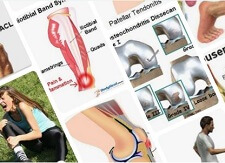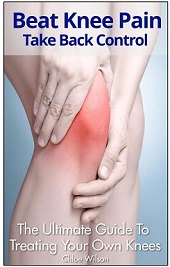- Home
- Knee Joint Anatomy
- Knee ROM
Knee Range Of Motion
Written By: Chloe Wilson, BSc(Hons) Physiotherapy
Reviewed by: KPE Medical Review Board
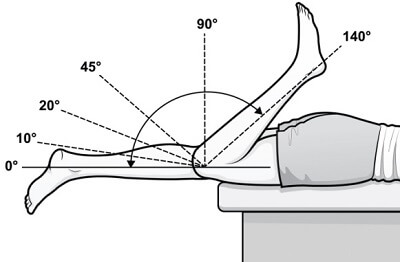
Having full knee range of motion (ROM) is really important for day to day function.
The knee needs to be able to bend and straighten so we can walk and run, support our body weight, control our balance and is an important shock absorber for our body.
When knee movement is limited, it causes pain, impairs function and makes us predisposed to knee injuries.
When we talk about knee range of motion, we are looking at how much movement there is at the knee. The main movements at the knee are flexion and extension i.e. bending and straightening of the knee. There is also a small amount of rotation.
Here we will look at the different types of knee range of motion, the normal ranges of motion, how much range is required for different functional activities, how to measure knee ROM, what restricts range of motion and how to increase range of motion.
What Is Knee Range of Motion?
There are three different ways of looking a knee range of motion:
- Active Knee ROM: This is how much the knee can bend and
straighten on its own i.e. knee muscles actively contracting without any external
help
- Passive Knee ROM: How far the knee can bend and straighten when
moved by an external force, usually another person – the leg and knee muscles
completely relaxed
- Active Assisted ROM: How far the knee can move when it is weak or in pain with some assistance – knee muscles are working to move the leg but with some help e.g. from a therapist
It is normal for passive knee range of motion to be slightly greater than active range of motion.
These three range of motions, in a healthy, pain-free joint, will be similar, but if you have injured your knee, have pain in your knee or a knee condition such as arthritis, chances are your range of motion will be less than normal with active range of motion being most affected.
What is Normal Knee Range of Motion?
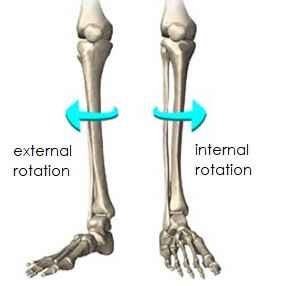
Normal knee range of motion refers to how much the knee bends and straightens. There is also a small amount of rotation at the knee, typically measured when the knee is bent.
Normal active knee range of motion is:
- Knee Flexion ROM: 135o i.e. fully bent
- Knee Extension ROM: 0o i.e. fully straight
- Internal Knee Rotation ROM: 10o
- External Knee Rotation ROM: 30-40o
Normal passive knee ROM is:
- Passive Knee Flexion ROM: up to 150o, depending on the size of the leg – the limit is the calf pushing onto the back of the thigh
- Passive Knee Extension ROM: up to 10o hyperextension is considered normal
What Is Normal Functional Knee ROM?
Functional range of motion is how much movement is needed for typical daily activities such as walking, climbing stairs and squatting down.
At the knee joint, most functional activities require up to 120 degrees of knee flexion, rather than the full 135 degrees, however, virtually all functional activities require full knee extension.
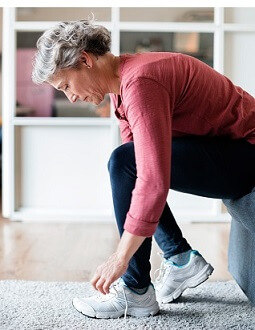
The normal knee ROM required for activities of daily living is:
- Walking: 0-65o
- Climbing Up Stairs: 0-85o
- Descending Stairs: 0-90o
- Sitting Down: 0-90o
- Standing Up From Sitting: 0-95o
- Tying Your Shoelace: 0-105o
- Picking An Object Up From The Floor: 0-75o
- Riding A Bike: 0-115o
- Squatting: 0-115o minimum
- Sitting Cross Legged: 0-115o
So as you can see, if knee flexion range of motion is slightly
limited, you should still be able to do most of your usual activities. But
losing just a few degrees of knee extension range of motion can have a massive impact on
functional ability.
How To Measure Knee Range Of Motion
The most accurate way to measure knee range of motion is to use a goniometer. A goniometer is essentially a specially designed protractor that measures joint angles.
There is a circle in the middle of a goniometer representing 360o of motion, out of which come two extending arms: a stationary arm (connected to the protractor) and a moveable arm.
When measuring knee range of motion, you need to identify three landmarks on the leg:
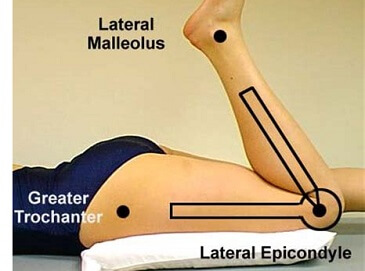
- Knee: Lateral Epicondyle – the midpoint of the outer knee
- Ankle: Lateral Malleolus – the bony lump on the outer side of the ankle
- Hip: Greater Trochanter – a bony lump just below the hip joint on the outer side of the thigh.
Ideally, you will need someone to do the measuring for you – it is hard to get an accurate measurement of knee ROM if you try and do it yourself.
To find the greater trochanter, find the midpoint of the bony ridge on the top of your pelvis (the iliac crest) and bring your fingers down 15-20cm until you feel a bony lump. The greater trochanter is more towards the back of the thigh than the front due to the large muscle bulk of the quads on the front of the thigh. You will have to press in through the soft tissues of the thigh to feel it.
The best way to measure knee range of motion is to:
- Lie down on your back with your leg straight, on a flat, preferably hard surface
- Place the axis of the goniometer over the lateral femoral epicondyle
- Line the stationary arm of the goniometer up with the greater trochanter along the outer thigh
- Line the other arm of the goniometer up with the lateral
malleolus of the ankle
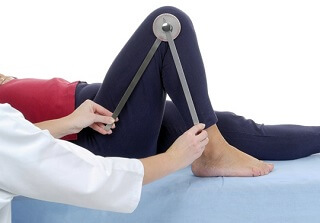
- To measure knee extension, gently push your knee down into the floor (using your leg muscles not your hands) so the knee is as straight as it goes and measure
- To measure knee flexion, bend the knee as far as you can, by sliding your foot up towards your buttocks, keeping the arms and axis of the goniometer in place, then measure
If you prefer, you can measure knee flexion in sitting, as long as your leg can move freely. It works best to sit on a high chair or the edge of a table. Line up the goniometer as described above and then bend your knee as much as you can
How To Measure Knee ROM Without A Goniometer
If you don’t have a goniometer, you can still assess your knee ROM. This can be really helpful for seeing what progress you are making with your rehab after a knee injury. It won’t be as accurate as using a goniometer, but it does give you somewhere to start.
If you are wanting to "guestimate" the range of movement at your knee, try this:
Estimating Knee Extension ROM
- Lie on your back on a firm surface
- Push your knee down into the floor (using your leg muscles not your hands)
- Slide your hand, palm down, underneath your knee. If you can:
a. Just get a couple of your fingers underneath with difficulty = 0o extension
b. Just slide all your fingers underneath = +5o degrees i.e. lacking 5o extension
c. Easily slide your whole hand underneath = +10o i.e. lacking 10o extension
d. Can’t get any of your fingers underneath = -5o or more i.e. hyperextension
Estimating Knee Flexion ROM
- Lie on your back on a firm surface
- Slide your heel along the floor towards your bottom
- Measure the distance from the back of your heel to your bottom
This doesn’t give you an actual measurement of flexion, but it does give you a measurement to compare with when monitoring you progress when trying to improve knee flexion.
Measure Knee ROM With Your Phone
There are also various apps that you can download that essentially turn your phone into a goniometer. They vary in quality but a study* published in Physiotherapy Journal found that the "Knee Goniometer" App installed on an iPhone was a reliable tool.
What Restricts Knee ROM?
There are a number of things that can restrict normal knee range of motion, the most common being:
- Swelling: increased fluid inside the knee joint restricts movement. Find out how to reduce knee swelling to regain knee ROM
- Pain: when pain is bad, it can stop us wanting to move the knee
- Stiffness: knee stiffness is a common problem where there is a loss of end range flexion and/or extension, reducing knee range of motion
- Impingement: where something gets stuck inside the joint and blocks movement e.g. meniscus tear
- Muscle Tightness: tight muscles may limit how much the knee can bend or straighten. Knee stretches can really help to improve your flexibility and knee ROM
- Muscle Weakness: if there is sufficient loss of muscle power, then you might not be able to fully bend or straighten your knee. Knee strengthening exercises are the best way to combat this
- Wear & Tear: degeneration of the knee bones and the formation of bone spurs can impede knee movement, most typically due to knee arthritis
How To Increase Knee ROM
There are loads of things you can do to increase knee range of movement. Gaining even just a few degrees of movement, particularly knee extension, can make a massive difference.
Some of the most effective ways to increase knee range of motion include exercises, activity modification, joint mobilisations and making changes to your diet.
You can find out loads more about these different options and loads more in the How To Improve Knee Flexibility section.
You may also be interested in the following articles:
- Hip Range Of Motion
- Knee Pain At Night: Diagnosis & Treatment
- Knee Pain On Stairs: How To Beat It
- How To Reduce Knee Swelling
- Knee Strengthening Exercises: Beginners To Advanced
- Knee Stretches: Improve Your Flexibility & Mobility
- Common Knee Symptoms: What They Mean & How To Treat Them
Related Articles
References
1. Physiotherapy Journal: The knee smartphone-application goniometer is a more reliable tool than the standard goniometer in acute orthopaedic settings. L. Pereiralow, L.Pereira, S. Rwkabayiza, E. Lécureux, B. Jolles. May 2015
Page Last Updated: September 6th, 2025
Next Review Due: September 6th, 2027

